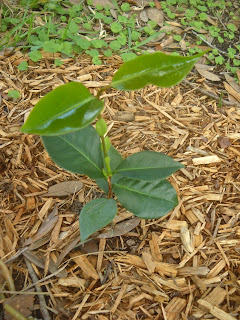 |
| My late grandmother Chessie Pearce's camellia Camden County, North Carolina Photographed by Edward L. Pearce |
This past Saturday the Coastal Carolina Camellia Society held its annual camellia show. According to the Society's FaceBook page, more than 1,000 blooms were entered. I intended to go across town to view the entries, but got busy and forgot until too late. What a great opportunity it would have been to learn more about camellias.
My grandmother, Chessie Pearce, grew a camellia tree in her garden. The tree is at least sixty-five years old but possibly much older. My brother Edward remembers our grandmother saying camellias should be planted on the north side of a pine and also remembers her calling her tree a japonica. Sometime during the 1970s temperatures dropped below zero and the freeze damaged Grandmama's tree. After Edward cut it back to about five feet, it revived. Now, forty-five years after our grandmother's death, the tree is approximately eighteen feet tall and blooms prolifically.
 |
| Chessie Pearce's camellia tree is more than 65 years old Photographed by Edward L. Pearce |
My knowledge of camellias is not extensive. I'm familiar with japonicas and sasanquas, and with camellia sinensis, the tea plant. These are not, however, the only species of camellias and after doing a bit of reading, I realize it's quite possible that some of the camellias I believed to be japonicas are not.
Here's the local conventional wisdom: Japonica blossoms make beautiful cut flowers, perfect for floating in a glass bowl indoors or in a birdbath outdoors. Sasanqua blossoms don't last when cut.
Where I live, the sasanquas usually bloom from September to November and japonicas bloom in the winter.
 |
| This red and white variegated variety grows in my front yard |
 |
| This cream colored camellia sporting a wealth of stamens grows near my front door |
 |
| A pink and white variegated variety growing in my front yard |
My one-third acre lot contains a number of camellias. Some, or all, of the seven that came with the house, when I bought it, had been transplanted here from Summerville when the prior homeowner moved his parents into assisted living. One of the seven budded yearly, but never bloomed, and succumbed during a cold winter several years ago. A single one of the remaining six is a sasanqua, which I've had cut back, but has resumed growth. I always assumed the other five were of the japonica species, but after perusing the American Camellia Society's website this afternoon, I'm not so certain.
My older japonicas produce seeds. In the last three years volunteers have sprouted under an old pink-blossomed tree. With varying success, I've transplanted seedlings to other spots in my yard. I've also given a few away.
When I intentionally planted camellia seeds in the past, either they didn't grow, or I forgot where I planted them and accidentally mowed them down. The seedlings are similar in appearance to those of the homely wild cherry trees that, due to bird droppings, each year produce hundreds of seedlings under my huge live oak and a variety of other shrubs and trees.
My sister Martha Ann in northeastern North Carolina had success growing a camellia from a seed I gave her years ago. One of her animals, a goat, attempted to eat the small shrub, but now it's growing back.
 |
| This past August I harvested seeds from the five older japonicas |
 |
| On the grounds of the Berkeley County Library, Daniel Island, SC |
 |
| On the Rokko Island greenway, Kobe, Japan |
As a result of having family members living in Japan, I have been able to view camellias in bloom at Tenryū-ji and other gardens in Kyoto, as well as, in and around Kobe.
 |
| One of a group of camellia trees growing out of rock on a hillside above Kobe, Japan in late November |
There are plenty of opportunities to see camellias blooming in the American South. At this time of year a stroll through older neighborhoods, such as the one where I live, is a treat for a camellia lover.
Two weeks from today, Middleton Place begins its annual guided Camellia Walks. Botanist Andre Michaux is said to have introduced the camellia japonica there around 1785.
 |
| This japonica by my laundry room thrives on afternoon sunlight but needs some TLC |
 |
| Seed pods in situ |
 |
| A volunteer that I transplanted |
 |
| April at Tenryū-ji temple gardens in Kyoto, Japan |
 |
| A leaf wants to hide this pretty pink blossom at Tenryū-ji |
 |
| A variegated blossom at Tenryū-ji |
 |
| This one grows by my laundry room |
Thank you for visiting The Traveling Gardener.
Your comments are welcome.
Your comments are welcome.












